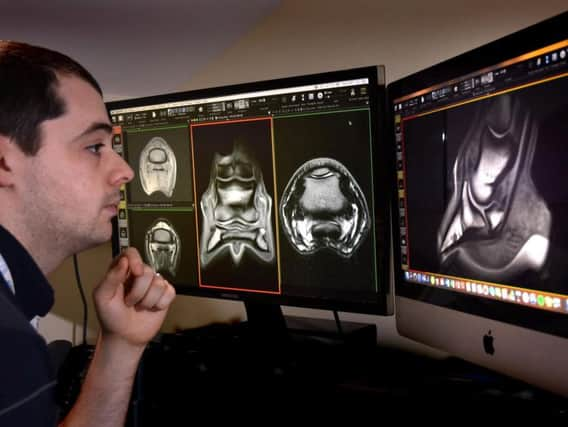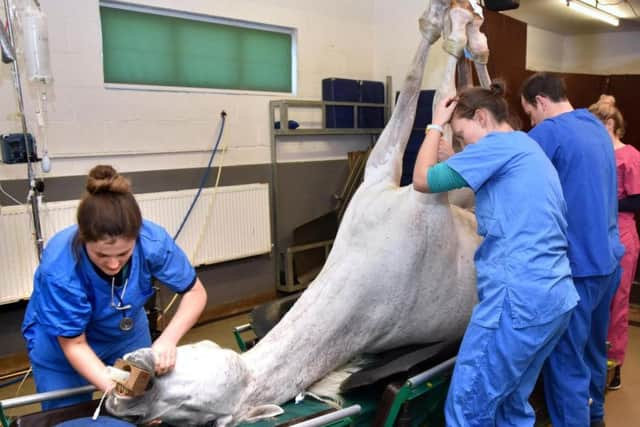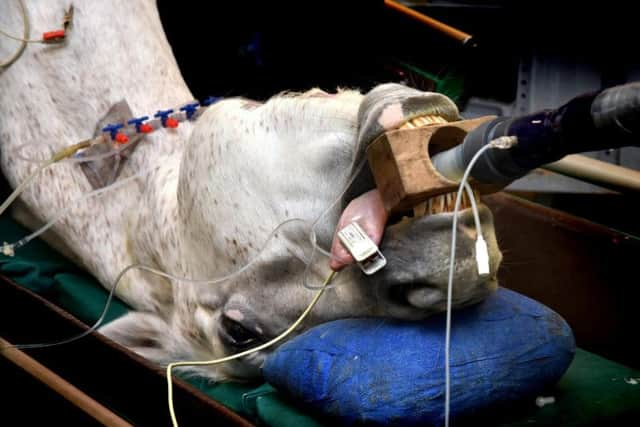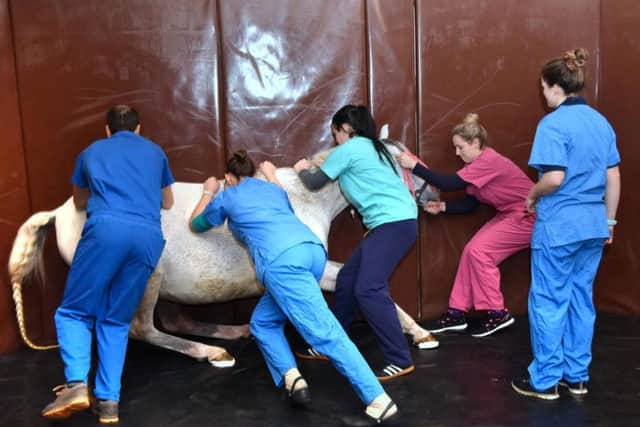These brilliant pictures show what happens behind the scenes in a Yorkshire horse hospital


The 10ft steed is seen laid unconscious on its back as staff perform keyhole surgery to treat ligament damage in its hock and a bone splinter following an unspecified accident.
The operation is one of many carried at the Rainbow Equine Hospital based in an old farmhouse on the outskirts of Malton, North Yorkshire.
Advertisement
Hide AdAdvertisement
Hide AdAround 80 per cent of patients are admitted due to issues related to lameness but surgeons can deal with more severe injuries like Cinders who was disfigured in a suspected acid attack.


The pony underwent a “world-first” surgery involving fish skin being sewed into her face after rescuers found her abandoned in Chesterfield, Derbys., last year.
The medical set-up at the hospital is indeed largely the same, except that everything is oversized.
The doors are bigger, the corridors are wider, and large inflatable pillows are used to stop horses from rolling over when on the operating theatre.
Advertisement
Hide AdAdvertisement
Hide AdThere are outbuildings housing scanning equipment, a computer suite and a fully-stocked laboratory with microscopes, centrifuges, hormone analysers, biochemistry analysers, incubators and arrays of test-tubes and petri dishes.


The team consists of 54 surgical specialists, medical specialists, dental specialists, a radiographer, anaesthesiologists, vet interns, vet nurses.
The hospital has been quietly evolving for 30 years and it’s now almost unique in the north of England.
It was founded in the 1980s by Bob Ordidge and Leuan Pritchard in the very premises it still occupies.


Advertisement
Hide AdAdvertisement
Hide AdAt the time it was a mixed ambulatory practice - Bob and Ieu would go out on the road each week to clients in Hull, as well as spending time at the clinic.
Ordidge and Pritchard, as it was known, became Rainbow Equine in the 1990s when a vet called Alistair Nelson joined and became partner.
Alistair, who died of a heart attack in 2009 aged just 46, was described by Bob as “the Einstein of the veterinary world”.
A Cambridge graduate and expert in lameness diagnosis, he drove huge technological advancements, including designing the first-ever standing computerised tomography (CT) scanner for horses.
Advertisement
Hide AdAdvertisement
Hide AdOne key change at Rainbow over the last 30 years is how, just like in human medicine, everything is becoming more specialised.
In diagnostics, there’s nuclear scintigraphy, CT, and, importantly, MRI.
“We use MRI for looking at horses’ feet,” says surgeon, Jonathan Anderson.
“About 80 per cent of lameness problems are in the foot. With an x-ray, all you can see in a horse’s foot is the bones - you can’t see all the soft tissues.
Advertisement
Hide AdAdvertisement
Hide Ad“A horse’s digits are compressed into one and the ligaments and tendons and muscles are all in the hoof. MRI transforms what we can do.
“For us, to image a horse is everything. In the human world, if you had a broken bone or had something wrong in your head, an MRI or CT is just the next thing, it’s so easy.
“But with horses, because they’re so big, there’s no CT big enough. Alistair designed this way we could CT horses’ heads and legs.
“It really was amazing. He was the first guy to do it. And now the systems are all over the States, and they’re all over the UK. So that was a useful technology for us to develop.”
Advertisement
Hide AdAdvertisement
Hide AdOne of his latest cases involved a horse who had an unspecified accident in its field and had ligament damage in its hock, and a splinter of bone which needed to be removed.
The offending leg was raised up by rope and Jonathan went in through a keyhole incision, threading a tiny camera into the leg.
A small video screen mounted over the surgical table showed the problem almost immediately.
But whatever condition the horses come in with, the chances are it can be treated at the hospital.
Advertisement
Hide AdAdvertisement
Hide AdThe MRI at Rainbow Equine Hospital recently passed a landmark - 1,000 horses scanned. They undergo the non-invasive scan standing up.
Rainbow is one of the few equine hospitals to have the equipment and a specialist radiologist on-site. Another rare aspect of Rainbow is its lab.
“Rainbow has an independent lab so we get samples sent from all over the country.
“We’re the third biggest equine laboratory in the country. The other two are down south. There’s nothing else like it in the north.”
Advertisement
Hide AdAdvertisement
Hide AdThese capabilities all contribute to Rainbow’s offer to the equestrian community in Yorkshire and further afield.
The reputation of the hospital and the staff who work here brings in customers from all over the country.
The size and location of the hospital also draws people, but the hospital relies on referrals by equine vets, with whom they maintain good relationships.
